Early Verdict
Although Logitech does most things well in the implementation of its G Pro, certain aspects of this headset could use some work (particularly at a ~$100 price point). Still, gamers who take the leap won't be disappointed. Just don't expect class-leading musical reproduction.
Pros
- +
Comfortable fit
- +
Suitable for gaming
- +
Attractive design
Cons
- -
Price
- -
Dual-chamber technology isn't great for music
- -
Interior build quality could use some clean-up
Why you can trust Tom's Hardware

Logitech's G Pro is intended to round out the company's portfolio with something a little higher-end. Similar to Kingston's HyperX Cloud Alpha, this headset employs something called dual-chamber technology.
The design isn't exactly new. If you've been following our headset reviews, then you're already familiar with competing products that use drivers placed in their own separate chamber with openings to affect the sound's character.
Unboxing & Accessories
Inside the box, you'll find the headset, a clip-on microphone, a roughly 2m cable with an inline control unit and a combination 3.5mm jack for headphone in/microphone out, plus an 11cm splitter for branching those 3.5mm connections into separate plugs.

The cable is covered in a braided textile and is relatively soft. Logitech also includes brief instructions, plus a set of changeable ear cushions with a different type of imitation leather.

Comfort
Although Logitech's G Pro doesn't really stand out visually, that's not necessarily a bad thing. Its ear cups' shells are made of matte black ABS, and a white G logo is painted on their back side. We're glad to see Logitech dispensing with gaudy extras and distracting LEDs.


Overall, Logitech's workmanship seems acceptable (though not above-average). The G Pro is similar to Roccat's recently-reviewed Khan Pro in that regard.
Weighing just under 273 grams with its microphone, but without the cable, this isn't a particularly heavy headset either.


Headband adjustments are easy to achieve by pulling out and pushing in, with a tactile response accompanying the individual steps. You'll have no trouble dialing in a comfortable fit, regardless of whether your head is large or small.
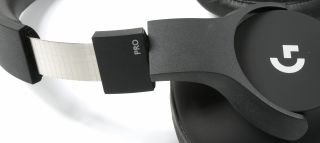
The joint mechanism works along two axes. It's purportedly made of nylon and significantly more durable than the thermoplastic polymer composing the shells.
We like the comfortable headband that's upholstered in the middle and covered with imitation leather. However, this padding could have been a little thicker.

The removable ear pads are made from the same material. They're comfortable enough for long-term use, too. A quilted seam on the outer edge prevents wrinkles from forming, so the cushions stay neatly sealed. Similarly, the inner covering is wrinkle-free and thin enough to not affect the sound. These are small details that not every manufacturer pays attention to.

Logitech includes interchangeable cushions with a slightly rougher surface in its accessory bundle. Still, they're an imitation material and not actually suede.

Foam rubber on the inside is firm, but rests comfortably over your ears.
Functionality & Interface
The G Pro is a wired headset, so there's a control unit built into Logitech's cable with a volume wheel and slide switch to mute the microphone. Both controls are easy to grip and intuitively accessible.

Similar to the mic, this headset's cables are completely removable. The plugs are tight, but it takes relatively little force to pop them in or out. The microphone has an additional lug in the plug to ensure it goes into the correct jack.
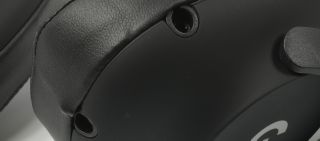
Drivers
A number of other headset vendors already utilize a similar double-chamber concept, so what makes the G Pro special?
Logitech does make some unique modifications. Up top, we see an opening for the drivers, along with two more holes covered with dust-proof material. Both openings provide an air outlet from the driver chamber to the front.


High frequencies from the 50mm neodymium drivers are radiated directly to your ears from the diaphragm. More openings on the side must be for fine-tuning bass response. But in our opinion, the whole dual-chamber technology concept seems overly manipulated, and not particularly well thought-out. More on that when we start digging through performance tests.
A bit of experimentation with damping the shell's large cavity makes the headset sound "colder," which certainly won't appeal to everyone.


Inside, we observe acceptable soldering quality, even if the injection-molded body is not cleanly deburred in certain places.
Microphone
Logitech's flexible gooseneck microphone is long enough for our tastes, and it holds whatever position you bend it into fairly well. A tight connection to the headset should prevent the mic from slipping out during use. Moreover, pop protection helps lessen the effect of fast-moving air over the element.

Measurements & Sound-Check
To read about our test methodology in depth, please check out How We Test Gaming Headsets, particularly page 6 where we detail the measurements we take.
We start with a measurement of the microphone's frequency range. For this test, we use a calibrated mic (for reference) in our purpose-built measuring room. This allows us to take comparative measurements and generate a curve that comes close enough for what we're trying to do (even if it isn't the most ideal method for testing this mic). So, while the limitations of our equipment don't allow us to calculate the microphone's exact frequency response, we do have a reasonable approximation to confirm our subjective impression.
According to our equipment (and ears), the levels drop off sharply below ~100 Hz. Raising the lower mids and upper bass make voices sound more warm and full. And a difference of 10 dB from 100 Hz to 6 kHz modulates the most superficial highs, which never end up sounding metallic. This profile has broad appeal and is sufficient for good voice transmission. Sensitivity and background noise are both fine, in our opinion.
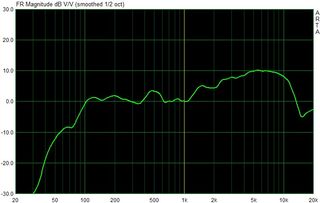
Headphone Measurement
The curve looks pretty good except for small dents around 350 Hz and 4.5 kHz. We can already see that this is not a bass-heavy headset. Rather, the G Pro appears fairly neutral at first glance.
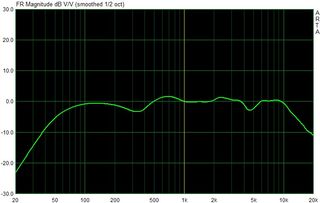
We did toy around with the lowest bass levels, raising them at 64 and 32 Hz. However, that made a mess of level stability and transparency. Avoid making the same mistake.
Subjective Audio Experience
Now let's subjectively test Logitech's tuning efforts. We began by running the headset for two days straight at a source with decent sound levels to make sure it is properly broken in.
Bass Reproduction
We test the lowest bass in the sub-contra octave (16.4 Hz to 32.7 Hz) with a recording of Bach's Toccata and Fugue in D minor (19 and 25 Hz), as well as the festival overture composed in 1880 by Tchaikovsky (10 Hz and 12.5 Hz). The same applies to the lower ranges of the contra octave (32.7 to 65.4 Hz). The large bass drum, usually tuned to ~55 to 60 Hz, is used to complete this evaluation.
The bass is deep. With shorter pulses and few competing sources, the principle behind Logitech's dual-chamber technology works quite well. But if, for example, the organ in the sub-contra octave presses constantly at higher levels, the entire sound image softens from below, roaring and booming.
The impact of a large bass drum, on the other hand, is sufficiently crisp. And level stability in games is completely acceptable for this price range. Although the G Pro doesn't deliver outstanding bass, low frequencies are still convincing (with certain caveats).
Upper bass, up to 150 Hz, contains the male voice's fundamental speech frequency. Thus, it has a strong influence on the lifelike reproduction of male vocals.
This range, on the other hand, sounds coherent and natural. Male vocals are reproduced rather warmly, and instruments remain largely unaltered. All in all, the resolution is still good, allowing single sources to perform acceptably.
Mid-Range
The lower mid-range (sometimes called "fundamental range") spans from ~150 to 400 Hz. Together with the upper bass, this range plays an important role in producing the subjectively perceived warmth and fullness of sound. This is also where the fundamental range of female vocals can be found.
Female vocals sound good. The timbre of recorded instruments can also be described as warm across this range. Resolution, on the other hand, is rather mediocre. Fortunately, when it comes to gaming, such a shortcoming doesn't really affect your experience.
The upper mid-range, from 400 Hz to about 2 kHz, contains the 1 kHz point that's used as a reference for many measurements. Unfortunately, this is often very noticeable, especially with cheaper devices, as manufacturers tend to overemphasize it a bit. This frequency range also plays a significant role in gaming, and its balanced reproduction contributes significantly to good spatial resolution.
All instruments offer the nuances we want to hear, and the resolution is also good for this price range. However, some headsets and good hi-fi headphones simply offer more (though that's just us nitpicking).
Subjectively, instruments in the orchestra sound like they're positioned far enough apart from each other. That makes Logitech's G Pro a decent solution for listening to music. Really, though, it's better for gaming since the tuning concept is tailored to perform well in fast-paced shooters and stealth titles.
High-Frequency Range
Between 2 kHz and 3.5 kHz is where the human ear is most sensitive, especially since the lower levels of this range are responsible for the human voice's overtone reproduction. This frequency range is crucial to the recognition of a voice or an instrument. Thus, in this context, it also relates to the respective tone color, or timbre.
The G Pro still sounds natural and relatively neutral. Placing the source of sounds is incredibly important in games, and Logitech's latest does this well. Although we've tested headsets that fare even better, there are also worse headsets priced similarly. Musical reproduction remains solid; it's only at high levels that sound is crushed a bit.
The mid-high range (3.5 to 6 kHz) determines the success or failure of speech reproduction as a whole, since sibilant sounds (like the letter "s" and hiss sounds) fall into it. The upper trebles range up to about 10 kHz, where we pass into the territory of super-high frequencies.
The small dent in our observed curve is audible, particularly when you're listening for it. During games, however, it's hardly perceptible. Some sibilants sound more dominant than we'd like, but there is no hissing. They're not metallic, either. Only super-high frequencies weaken in brilliance due to Logitech's drivers.
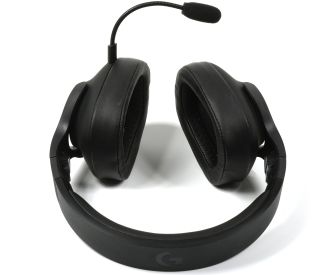
Conclusion
It would have been better for Logitech to skip the dual-chamber technology and instead use more sensitive drivers with sufficient damping. The smearing of bass at low levels is the result of its acoustic experiment, and that could have been avoided. The sound isn't bad, though. And for gaming, Logitech's G Pro is quite suitable.
Still, if we're putting together a wish list, we would have appreciated greater sensitivity, better level stability, and more nuanced bass reproduction. Loud isn't always good, dear designers.
Logitech's material choices are appropriate in the $100 price range. However, small flaws in the interior build quality are less acceptable. Even if most gamers won't see them, they can have an acoustic impact.
Overall, Logitech's G Pro is recommendable. It's all of those caveats that keep us from giving this headset an award, though.
MORE: Best Gaming Headsets
-
DerekA_C this is an esport headset NOT a music headset hence the mic boom why the HELL would you compare it to an audiophile device when it's sole purpose is for gaming.Reply -
The original Derfman At that price it should at least have a fader for talk and game like the SteelSeries Arctis series has. So much better to be able to instantly adjust the balance between chat and game.Reply -
Ninjawithagun G933 is the only way to go for true surround sound gaming. It is also the only headset on the market that is capable of rendering DTS-X and Dolby Digital ;-)Reply -
FormatC Reply
Please read this first for the basics and a better understanding: How We Test Gaming Headsets20837479 said:this is an esport headset NOT a music headset hence the mic boom why the HELL would you compare it to an audiophile device when it's sole purpose is for gaming.
All this eSports bubbles are pure marketing. They're looking for willing and bona fide victims, nothing else. Put a sticker with eSports or Gaming on an entry-level system and sell it as high-end gaming product. It works. In the article linked above you can see frequency band analyses of typical in-game soundscapes. This has nothing to do with audiophile, if you need a natural and spatially well positioned reproduction. Instruments, vocals, steps on concrete or battle noise - the principle and physical basics are in each case the same.
Just testing the Steelseries Arctis Pro. :)20835298 said:SteelSeries Arctis 5 for me thanks!


